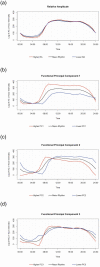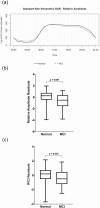Associations of actigraphic sleep and circadian rest/activity rhythms with cognition in the early phase of Alzheimer's disease
- PMID: 34095836
- PMCID: PMC8168567
- DOI: 10.1093/sleepadvances/zpab007
Associations of actigraphic sleep and circadian rest/activity rhythms with cognition in the early phase of Alzheimer's disease
Abstract
Study objectives: To compare sleep and circadian rest/activity rhythms (RARs), quantified by standard and novel actigraphic metrics, between controls and participants with mild cognitive impairment (MCI), and to examine the cross-sectional relationships between these measures and cognition.
Methods: Actigraphy data were collected in 179 older individuals (mean age = 72.6 years) with normal cognition (n = 153) and MCI (n = 26). Sleep parameters (e.g. sleep efficiency), and standard nonparametric RARs (e.g. interdaily stability) were generated. Functional principal component analysis (fPCA) was used to generate three novel RAR metrics (fPC1, fPC2, and fPC3). Cognitive composite scores reflecting episodic memory and executive function were derived using factor analysis. Regression models compared sleep and RAR parameters between diagnostic groups and their association with cognitive performance.
Results: Compared to controls, the MCI group exhibited lower levels of the standard RAR parameter: relative amplitude and fPC3-a novel RAR whereby lower scores reflected a lower rhythm peak, as well as greater nighttime activity and less activity in the morning. Across groups, several standard RAR parameters (e.g. interdaily stability) and fPC3 were associated with better episodic memory and executive function performance. Additionally, several standard RAR measures (e.g. relative amplitude) and the novel RAR measure fPC1 (reflecting the total volume of activity and rhythm strength) were associated with better executive function performance.
Conclusions: Individuals with MCI have altered circadian RARs compared to controls, including the novel RAR metric fPC3, reflecting greater nighttime activity and less activity in the morning compared to mean values. Additionally, these measures are significantly associated with cognitive performance.
Keywords: Alzheimer’s disease; actigraphy; circadian rhythms; cognition; sleep.
© The Author(s) 2021. Published by Oxford University Press on behalf of Sleep Research Society.
Figures



Similar articles
-
Association of Rest-Activity Rhythm and Risk of Developing Dementia or Mild Cognitive Impairment in the Middle-Aged and Older Population: Prospective Cohort Study.JMIR Public Health Surveill. 2024 May 7;10:e55211. doi: 10.2196/55211. JMIR Public Health Surveill. 2024. PMID: 38713911 Free PMC article.
-
Brain amyloid burden, sleep, and 24-hour rest/activity rhythms: screening findings from the Anti-Amyloid Treatment in Asymptomatic Alzheimer's and Longitudinal Evaluation of Amyloid Risk and Neurodegeneration Studies.Sleep Adv. 2021 Sep 19;2(1):zpab015. doi: 10.1093/sleepadvances/zpab015. eCollection 2021. Sleep Adv. 2021. PMID: 34661109 Free PMC article.
-
White matter microstructure statistically mediates associations between circadian rest/activity rhythms and cognition in older adults.Sleep Adv. 2025 May 5;6(2):zpaf027. doi: 10.1093/sleepadvances/zpaf027. eCollection 2025 Apr. Sleep Adv. 2025. PMID: 40463851 Free PMC article.
-
A Systematic Review of Evidence for a Role of Rest-Activity Rhythms in Dementia.Front Psychiatry. 2019 Oct 30;10:778. doi: 10.3389/fpsyt.2019.00778. eCollection 2019. Front Psychiatry. 2019. PMID: 31736798 Free PMC article.
-
An evidence map of actigraphy studies exploring longitudinal associations between rest-activity rhythms and course and outcome of bipolar disorders.Int J Bipolar Disord. 2020 Dec 1;8(1):37. doi: 10.1186/s40345-020-00200-6. Int J Bipolar Disord. 2020. PMID: 33258017 Free PMC article. Review.
Cited by
-
Circadian rhythm disruption and retinal dysfunction: a bidirectional link in Alzheimer's disease?Neural Regen Res. 2024 Sep 1;19(9):1967-1972. doi: 10.4103/1673-5374.390962. Epub 2023 Dec 15. Neural Regen Res. 2024. PMID: 38227523 Free PMC article.
-
Abnormalities of Rest-Activity and Light Exposure Rhythms Associated with Cognitive Function in Patients with Mild Cognitive Impairment (MCI).J Circadian Rhythms. 2023 Dec 28;21:4. doi: 10.5334/jcr.227. eCollection 2023. J Circadian Rhythms. 2023. PMID: 38162255 Free PMC article.
-
Executive Performance Is Associated With Rest-Activity Rhythm in Nurses Working Rotating Shifts.Front Neurosci. 2022 Feb 24;16:805039. doi: 10.3389/fnins.2022.805039. eCollection 2022. Front Neurosci. 2022. PMID: 35281500 Free PMC article.
-
Sleep Quality and Aging: A Systematic Review on Healthy Older People, Mild Cognitive Impairment and Alzheimer's Disease.Int J Environ Res Public Health. 2022 Jul 11;19(14):8457. doi: 10.3390/ijerph19148457. Int J Environ Res Public Health. 2022. PMID: 35886309 Free PMC article.
-
Rest-activity rhythm characteristics associated with lower cognitive performance and Alzheimer's disease biomarkers in midlife women.Alzheimers Dement (Amst). 2025 Apr 15;17(2):e70105. doi: 10.1002/dad2.70105. eCollection 2025 Apr-Jun. Alzheimers Dement (Amst). 2025. PMID: 40242837 Free PMC article.
References
-
- Vitiello MV, et al. . Sleep disturbances in patients with Alzheimer’s disease. Mol Diag Ther. 2001;15:777–796. - PubMed
-
- Ancoli-Israel S, et al. . Variations in circadian rhythms of activity, sleep, and light exposure related to dementia in nursing-home patients. Sleep. 1997;20(1):18–23. - PubMed
-
- Hatfield CF, et al. . Disrupted daily activity/rest cycles in relation to daily cortisol rhythms of home-dwelling patients with early Alzheimer’s dementia. Brain. 2004;127(Pt 5):1061–1074. - PubMed
-
- Witting W, et al. . Alterations in the circadian rest-activity rhythm in aging and Alzheimer’s disease. Biol Psychiatry. 1990;27(6):563–572. - PubMed
Grants and funding
LinkOut - more resources
Full Text Sources

